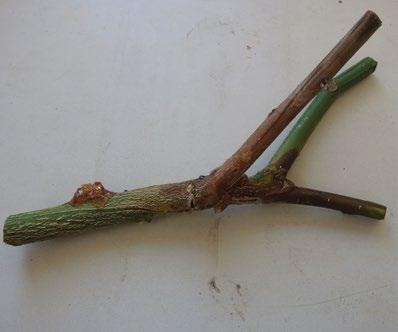
3 minute read
Colletotrichum affecting citrus
Is Colletotrichum affecting your citrus trees?
BY DR ANDREW TAYLOR RESEARCH OFFICER PLANT PATHOLOGY, DPIRD
Advertisement
In the spring and early summer period of 2020, some twig and shoot death were observed in citrus orchards around the South West region of Western Australia (WA).
Although this is not uncommon, the level of damage in some orchards was higher than that seen in previous years. In some orchards, significant twig death and leaf drop were observed. These symptoms can be caused by several factors such as poor nutrition, incorrect irrigation and poor canopy management. However, disease can also be the cause.
3 TREE showing dead twigs at the extremity of the tree. The fungus Colletotrichum, which is common throughout Australia, was isolated from samples collected from a limited number of these sites.
Colletotrichum species have a broad host range and are known to cause diseases among a range of horticultural crops including stone fruit, avocado and apples. Most commonly, they are associated with the disease anthracnose.
Colletotrichum species can be found in most orchards but may not be causing economic damage.
The Department of Primary Industries and Regional Development (DPIRD) is interested in hearing from commercial citrus growers who have experienced any symptoms (outlined below) in their orchards. Your reports will be a starting point to help us determine whether Colletotrichum is causing an economic impact within WA orchards. If you see symptoms in your orchard, please take a photo and send a report via the MyPestGuide Reporter app, which can be downloaded from agric.wa.gov.
au/apps/mypestguide-reporter.
Make sure location settings are enabled when you create your report and send it to ‘Colletotrichum survey’. Multiple reports can be made per orchard if symptoms are seen in different cultivars or citrus species. Please add the following details to your report in the ‘I found’ section: 1 Variety 2 Severity of damage (e.g. 10 per cent of trees with symptoms) 3 Do you think these symptoms have caused economic loss (e.g. 5 per cent economic loss)?
If you see symptoms in your orchard, report via the MyPestGuide Reporterapp.

3 LEAF infection with fungal spore bodies (black dots).

3 DEAD or dying shoots can be covered with black spore bodies (black dots).
3 LESIONS on shoots producing gummosis.
Background

As a number of Colletotrichum species are associated with different diseases and symptoms, the identification of individual species can be complex. With citrus trees, a number of different species of Colletotrichum have been associated with a range of symptoms, these include: • Twig dieback (Wither Tip), • Premature leaf drop, • Post bloom fruit drop (PBFD) and • Dark staining of fruit, which can result in postharvest fruit decay. A number of factors can influence the ability of Colletotrichum to cause disease. It is most common in seasons where prolonged wet periods are experienced in spring and when significant rains occur later in the season than normal. The Perth region experienced more than twice its average November rainfall in 2020. Symptom expression can also be influenced if trees are stressed due to other factors such as nutritional deficiencies, water stress or other diseases.
In the winter and spring period the fungus can develop on tree shoots, causing twig death.
Over the blossom period the fungus can also infect flowers, resulting in postbloom fruit drop. Leaves can become infected, causing leaf drop and dead patches on leaves. During wet weather, anthracnose spores can spread to fruit, infecting the rind and leaving dull, reddish-to-green streaks on immature fruit and brown to black streaks on mature fruit (tear stains). When the level of infection in an orchard builds up, especially under conditions which are favourable to the development of the disease, management can be more difficult. Management practices that will help reduce infection levels include: • Pruning out dead twigs from trees and removing these from the orchard • Removing leaves and fallen fruit from under trees (using a leaf sweeper followed by mulching) • Keeping weeds in your orchard under control • Drip irrigation of trees is preferable to sprinklers in relation to this disease, as sprinklers can continue the infection by wetting lower limbs and twigs on trees. If using sprinklers, keep trees well-skirted to reduce leaf wetting. Chemical control for this disease is limited for citrus in Australia as few chemicals known to control the fungus are currently registered.
MORE INFORMATION
Dr Andrew Taylor, Research Scientist Plant Pathology, andrew.taylor@dpird.wa.gov.au, (08) 9780 6241.










